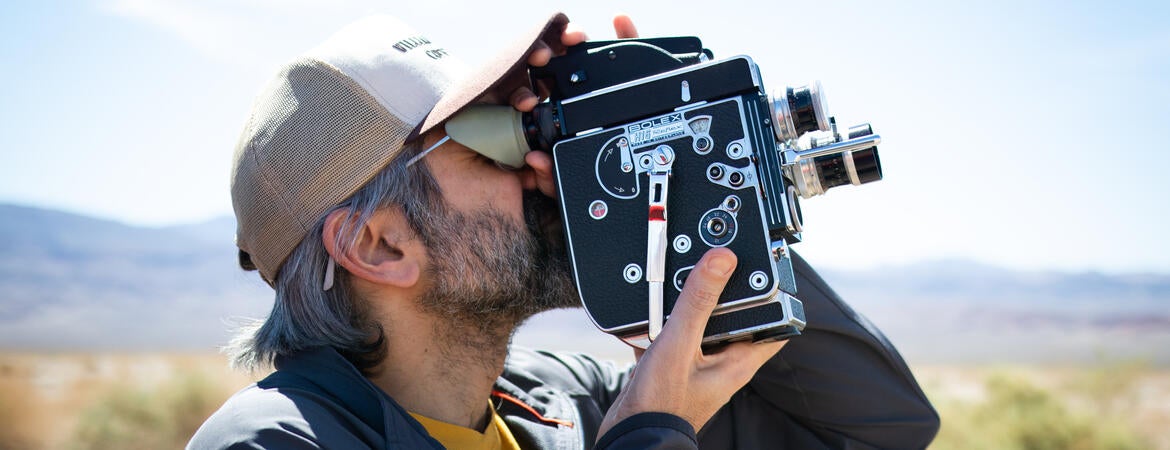College of Humanities, Arts, and Social Sciences

Theatre, Film, and Digital Production assistant professor of teaching Christophe Katrib has seen recent success for his work on his short film, “This Dissonance.” Its list of recent honors are as follows:
- The film was awarded Best Experimental Award at the University Film and Video Association (UFVA) conference in July, but also acquired a list of further accomplishments. It was chosen out of 3700 submissions from 125 countries to be part of the over 130-film Official Selection of the New Orleans Film Festival, which will be held in October.
- It was nominated for the Best Documentary Short award at the DOXA Documentary Film Festival in Vancouver, Canada in May.
- It was selected to screen in the ULTRAcinema Film Festival in Mexico in October and the Colorado Diasporic Film Festival at the end of August.
Katrib will be traveling to attend both the New Orleans and Colorado festivals. He has also been elected as a board member at large for the UFVA after only two years of membership.
“My film is kind of a poetic, experimental approach to documentary,” Katrib said. “So you can consider it a documentary film, but you can also consider it an experimental film. And it’s interesting because it’s been nominated for both of these classifications in different festivals.”
The film focuses on the tragedies the Palestinian and Lebanese people face, to whom Katrib has familial connection. The logline, or a brief summary of the film, reads, “American landscapes roll ominously while Palestinian and Lebanese voices permeate with poetry, hope, and pain.”
“I've been having great difficulty functioning, and I am not able to pretend like everything is normal,” Katrib said. “So I've been wanting to do something about that to not just witness and suffer and mourn, but to also use my voice, use my skills to do something about that.”
In August of 2024, while he was in New York, Katrib saw a call for film submissions by Mono No Aware, an analog film non-profit, which he felt was an opportunity to create something to release the mounting angst he had been feeling. With a deadline of October 31, Katrib only had about three months to work on the film. As such, he utilized footage that he had already filmed.
“I had been shooting a lot of film in those years, and also before,” Katrib said. “So, I started working with that footage, which ranged from recent to almost 10 years old. I started editing, and I made the visuals first. I was thinking about the sound as well, and I wanted to represent that idea of dissonance, which is what I was feeling living in a place that normalizes atrocity while watching it happen. So I wanted to create the sound separately to underline that dichotomy.”
Katrib created his soundtrack with audio from social media posts as well as recordings of his own music and ambient noises he made on his phone. The film was ultimately selected, and premiered at the Mono No Aware Cinema Arts Festival in December of 2024 as an “expanded cinema performance.”
“It starts in the dark,” Katrib said. “It starts with the sound of Israeli drones, and I perform a poem that I wrote, in the dark, with the sound of Israeli drones. Then the film starts, overlapping with the drones and the end of the poem. Toward the end of the film there's a second projector that's triggered and a woman comes up to the stage, and you see her shadow on the screen, and she plays the violin. She plays the very traditional scales that are from that part of the world — from Lebanon, Palestine, and Syria — improvised. And then another woman comes from the other side, and you also see her shadow on the screen and she recites a poem she wrote about the connection between Lebanon and Palestine and what's happening.”
The film was shot using a Bolex brand 16mm film camera. Katrib enjoys the physicality and the preciousness of film, as well as the consideration it requires. He believes that there are many things that students can learn from shooting with analog film.
“You can almost touch it,” Katrib said. “You can hear it, and you can touch it. The visual aesthetic of that image, how it flickers differently on the screen, the transitions between the shots in the camera, all the things that are part of it. For students, I think it can teach them to be more disciplined and more confident, more intentional, and to also prepare better. To be more focused and to care for every frame they shoot.”
This film represents a culmination of Katrib’s work, and a bridge between his creative practice and his pedagogy. He has given several workshops on the subject of analog film in the past, and has been applying to grants and fellowships to build it as a subject at UC Riverside to offer students new skills and possibilities.
Update: On November 7, Katrib won the Best Documentary Short award at the Beirut Shorts International Film Festival. This is an Academy Awards qualifying festival and category, making the film now eligible to be submitted for consideration for the 2027 Academy Awards.
FEATURED PHOTO. Professor Christophe Katrib shoots with his Bolex film camera. Photo by Nathan Baglyos.